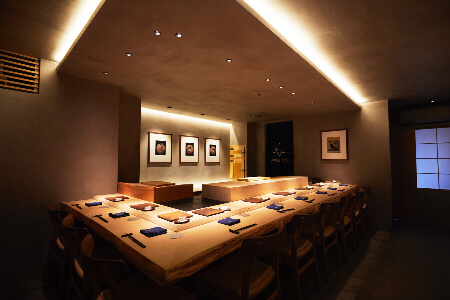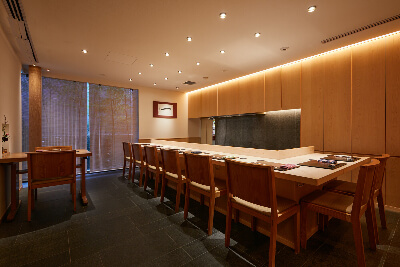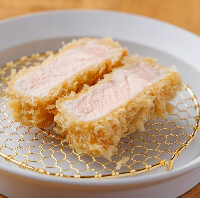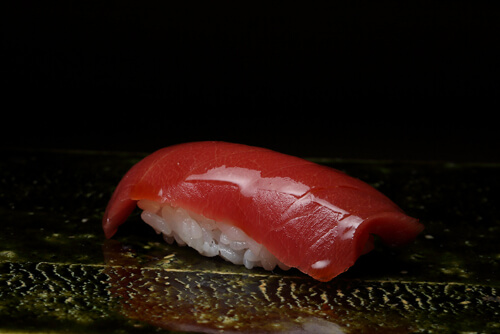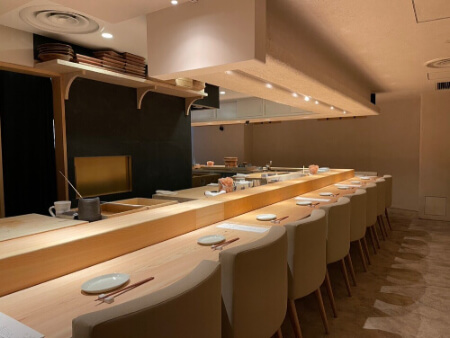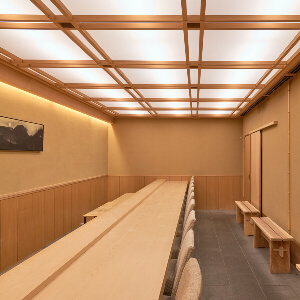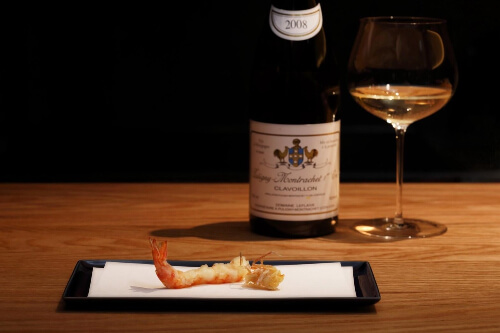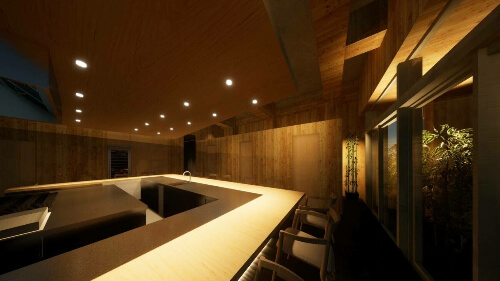Restaurants

Many different types of restaurants are found in Japan. Below we introduce some of the most popular restaurant types and their typical price ranges (per person):
Specialized Japanese restaurants
Many restaurants in Japan specialize in just one type of food:
- Sushi-ya (1,000 to 30,000 yen)
Sushi-ya are restaurants which specialize in sushi. In most sushi-ya, customers can sit either at a normal table or at a counter (sushi bar), behind which the sushi chef is working. - Kaitenzushi (1,000 to 3,000 yen)
Kaitenzushi are less expensive sushi restaurants, where the sushi dishes are presented to the customers on a conveyor belt. Customers can freely pick the dishes that they like as they pass in front of them or order dishes which are not available on the belt. The sushi is priced per plate with differently colored plates corresponding to different price tiers (typically 100-500 yen per plate) or by a flat rate. In the end, the plates are counted and the total amount is determined. - Soba-ya and udon-ya (500 to 1,500 yen)
Soba-ya specialize in soba noodle dishes and udon-ya in udon, but in practice both soba and udon can often be found in either type of restaurant. Most noodle dishes are served in a hot broth or come cooled with a dipping sauce on the side. The noodles may be ordered with different toppings (tempura, vegetables, etc.), and the menu may change with the seasons. - Ramen-ya (500 to 1,500 yen)
Ramen-ya specialize in ramen dishes, Chinese-style noodles served in a soup with various toppings. Every ramen-ya has developed its own soup, the most crucial ingredient for a restaurant's success. Several other dishes of Chinese origin, such as gyoza and fried rice, are also usually available at ramen-ya. - Kare-ya (500 to 1,500 yen)
Kare-ya are restaurants that specialize in Japanese-style curry rice dishes. There is usually at least one kare-ya and one ramen-ya inside or around major railway stations. - Gyudon-ya (500 to 1,000 yen)
Gyudon-ya specialize in gyudon (beef domburi). Gyudon-ya are among the most inexpensive fast food style restaurants and found all across the country. - Yakitori-ya (1,000 to 2,500 yen)
Yakitori-ya specialize in yakitori, grilled chicken skewers which are usually grilled to order over a charcoal fire. They are particularly popular among salarymen after work, and, together with ramen-ya, a popular place to go for a late night snack after drinking. - Okonomiyaki-ya (1,000 to 2,000 yen)
Okonomiyaki-ya specialize in okonomiyaki and sometimes monjayaki. At some restaurants, customers prepare their okonomiyaki by themselves on a hot plate built into the table. - Tonkatsu-ya (1,000 to 2,000 yen)
Tonkatsu-ya serve tonkatsu, deep fried breaded pork cutlets. - Tempura-ya (1,000 to 4,000 yen)
Tempura-ya specialize in tempura dishes, such as tendon (tempura domburi) and assorted tempura. - Unagi-ya (2,000 to 6,000 yen)
Unagi-ya specialize in unagi (freshwater eel) dishes such as unajuu, grilled eel served in a box over rice, and unadon (unagi domburi). - Sukiyaki-ya and shabu shabu-ya (5,000 to 15,000 yen)
Sukiyaki-ya specialize in sukiyaki, while shabu shabu-ya focus on shabu shabu. These types of restaurants are also often found in large, Western-style hotels and tend to be on the expensive side. - Teppanyaki-ya (5,000 to 20,000 yen)
At teppanyaki restaurants, the chef prepares meat, seafood and vegetables on a large iron griddle (teppan) in the presence of the customers who sit around the griddle. Teppanyaki restaurants are commonly found at nicer hotels and are usually pretty expensive. They are a popular place to enjoy premium Japanese beef (wagyu) such as Kobe Beef.


General restaurants
The following are some restaurant types that offer a broader range of dishes than specialized restaurants:
- Izakaya (1,000 to 5,000 yen)
Izakaya, like pubs, are casual drinking establishments that also serve a variety of small dishes, such as yakitori, other grilled food, salads and other finger foods. They are among the most popular restaurant types in Japan, and many of them are found around train stations and shopping areas. Dining at izakaya tends to be informal, with dishes shared amongst the table rather than eaten individually. - Family restaurant (1,000 to 2,000 yen)
Family restaurants (famiresu), such as Gusto, Royal Host, Saizeria and Joyful, are casual dining restaurants that typically belong to a nationwide chain and offer a variety of Western, Chinese and Japanese dishes. Family restaurants are more commonly found in the countryside than in large urban centers. - Shokudo (1,000 to 2,000 yen)
Shokudo are casual restaurants, similar to family restaurants, but tend to be small, independently owned and feature mostly Japanese-style food such as soba, udon, donburi and curry. Shokudo are commonly found around tourist sites. - Teishoku-ya (1,000 to 2,000 yen)
Teishoku-ya are restaurants that serve set menus (teishoku). Teishoku typically consists of a main dish such meat of fish, a bowl of cooked rice, pickles and miso soup. Teishoku-ya are especially numerous in business areas and popular during lunch time. - Kissaten and coffee shops (500 to 2,000 yen)
Kissaten are coffee shops that typically also serve some sweets, sandwiches or salads. Some of them also offer a few hot dishes, such as pasta. They are often found in museums, shopping areas and department stores. Chain coffee shops such as Starbucks, Doutor, Komeda and Tully's are also very popular and numerous. - Kaiseki ryori and ryotei (3,000 to 20,000 yen)
Kaiseki ryori may be called "Japanese haute cuisine". It is a refined multi-course cooking style which emphasizes seasonality, simplicity and elegance. It can be enjoyed at special kaiseki ryori restaurants or at ryotei, expensive and exclusive Japanese restaurants. Many of the better ryokan also serve kaiseki ryori. - Yatai (500 to 2,000 yen)
Yatai are movable food stalls that sometimes include seating space inside a tent. Their number has been decreasing over the years. Fukuoka is particularly famous for its yatai. Commonly sold items include ramen, oden, yakitori and the like.


Foreign cuisine
Many restaurants in Japan specialize in a foreign cuisine such as Korean, Chinese and Italian cooking. American-style fast food also enjoys a great popularity.
- Yakiniku-ya (1,500 to 7,500 yen)
Yakiniku-ya specialize in Korean-style barbecue, where small pieces of meat are cooked on a grill at the table. Other popular Korean dishes such as bibimba, reimen and chige are also usually available at a yakiniku-ya. - Chinese restaurants (1,000 to 5,000 yen)
There are many Chinese restaurants in Japan. Many of them serve Japanized Chinese dishes, while others offer more authentic Chinese food. - Yoshoku-ya (1,000 to 3,000 yen)
Yoshoku-ya specialize in yoshoku ryori, Western dishes that were introduced to Japan during the Meiji Period (1868-1912) and were subsequently Japanized. Typical dishes served at yoshoku-ya include omelet rice, hamburg steak and hashed beef on rice. - Italian restaurants (1,000 to 3,000 yen)
Italian cuisine is very popular, and pasta restaurants can be found across Japan. Many feature some Japanized pasta dishes on their menus (for example tarako spaghetti) alongside more conventional pasta dishes. - French restaurants (1,500 to 20,000 yen)
French restaurants are popular across Japan. They tend to be trendy and expensive, and are often found in good hotels. - Hamburger fast food (500 to 1,500 yen)
There are many hamburger fast food restaurants across Japan. They include major American chain stores such as McDonald's and Burger King, but also various local chain stores such as Mos Burger, Freshness Burger and Lotteria. - Indian restaurants (1,000 to 3,000 yen)
Indian restaurants are fairly common across Japan, especially around major train stations and shopping arcades. They serve Indian curry - as opposed to Japanese-style curry - and most have some vegetarian dishes on their menus. - Ethnic cuisine (1,000 to 3,000 yen)
In Japan, "ethnic cuisine" refers to South East Asian food, such as Thai, Indonesian and Vietnamese food. These restaurants are not as common as the other types listed above, but can often be found on the restaurant floors of larger department stores.


Questions? Ask in our forum.
Links and Resources
Restaurants
Recommended in Japan
-
-
![]() Udatsu Sushi (Tokyo)Awarded One Star in 2024 - People from around the world visit to experience Mr. Udatsu's sushi. Inside the restaurant, which resembles an art gallery with its modern decor and numerous artworks, guests can enjoy sushi crafted from the highest quality ingredients. While the foundation is traditional nigiri, the menu also features original creations born from the chef's relentless curiosity and innovation.View on JapanEatinerary
Udatsu Sushi (Tokyo)Awarded One Star in 2024 - People from around the world visit to experience Mr. Udatsu's sushi. Inside the restaurant, which resembles an art gallery with its modern decor and numerous artworks, guests can enjoy sushi crafted from the highest quality ingredients. While the foundation is traditional nigiri, the menu also features original creations born from the chef's relentless curiosity and innovation.View on JapanEatinerary -
![]() Waketokuyama (Tokyo)Awarded One Star in 2025 - With a meticulous focus on allowing guests to enjoy seasonal ingredients at their peak, the menu changes approximately every two weeks. The signature dish, "Grilled Abalone with Seaweed Aroma," features thick slices of abalone generously coated in a rich liver sauce, offering an exquisite taste of the sea.View on JapanEatinerary
Waketokuyama (Tokyo)Awarded One Star in 2025 - With a meticulous focus on allowing guests to enjoy seasonal ingredients at their peak, the menu changes approximately every two weeks. The signature dish, "Grilled Abalone with Seaweed Aroma," features thick slices of abalone generously coated in a rich liver sauce, offering an exquisite taste of the sea.View on JapanEatinerary -
![]() Sushiroku (Osaka)Awarded One Star in 2024 - A cozy, family-run restaurant managed by a husband and wife. They are deeply committed to perfecting their shari (sushi rice) and use two types of vinegared rice tailored to complement each topping. Since 2019, the restaurant has consistently earned stars.View on JapanEatinerary
Sushiroku (Osaka)Awarded One Star in 2024 - A cozy, family-run restaurant managed by a husband and wife. They are deeply committed to perfecting their shari (sushi rice) and use two types of vinegared rice tailored to complement each topping. Since 2019, the restaurant has consistently earned stars.View on JapanEatinerary -
![]() Fry-ya (Tokyo)Exquisite fried dishes crafted by a head chef with experience earning stars in both Switzerland and Japan. The remarkably light tonkatsu is a favorite not only among Japanese diners but also among visitors to Japan. With the theme of "small portions, many varieties," guests can enjoy sampling a wide selection of tonkatsu in smaller portions.View on JapanEatinerary
Fry-ya (Tokyo)Exquisite fried dishes crafted by a head chef with experience earning stars in both Switzerland and Japan. The remarkably light tonkatsu is a favorite not only among Japanese diners but also among visitors to Japan. With the theme of "small portions, many varieties," guests can enjoy sampling a wide selection of tonkatsu in smaller portions.View on JapanEatinerary -
![]() Sushi Hayashi (Kyoto)Awarded One Star in 2024 - A unique sushi restaurant that blends traditional Edomae (Tokyo-style) sushi with Kyoto-style sushi, such as mackerel sushi and steamed sushi, in its courses. The head chef, who trained as a sushi artisan in Switzerland, carefully selects Swiss wines, making them a perfect pairing to enjoy with the meal.View on JapanEatinerary
Sushi Hayashi (Kyoto)Awarded One Star in 2024 - A unique sushi restaurant that blends traditional Edomae (Tokyo-style) sushi with Kyoto-style sushi, such as mackerel sushi and steamed sushi, in its courses. The head chef, who trained as a sushi artisan in Switzerland, carefully selects Swiss wines, making them a perfect pairing to enjoy with the meal.View on JapanEatinerary -
![]() Hikarimono (Tokyo)With a prime location and quality that rivals high-end sushi restaurants, this restaurant maintains the goal of being a place for everyday dining. It offers a casual and relaxed atmosphere, free from stiffness or formality. The signature "Hikari-maki," featuring ingredients such as sardines, pickled plum, and bettarazuke (sweet pickled radish), boasts unique flavors that are especially popular among international visitors.View on JapanEatinerary
Hikarimono (Tokyo)With a prime location and quality that rivals high-end sushi restaurants, this restaurant maintains the goal of being a place for everyday dining. It offers a casual and relaxed atmosphere, free from stiffness or formality. The signature "Hikari-maki," featuring ingredients such as sardines, pickled plum, and bettarazuke (sweet pickled radish), boasts unique flavors that are especially popular among international visitors.View on JapanEatinerary -
![]() Noguchi Tsunagu (Kyoto)Awarded One Star in 2024 - The sister restaurant of the highly exclusive Japanese cuisine establishment, Kyotenjin Noguchi. While maintaining the culinary essence of the main branch, this kappo-style restaurant incorporates ingredients from the chefŌĆÖs hometown in the Goto Islands. Its signature dish, Nikusui, is a masterpiece made from carefully prepared, top-quality A5-grade sirloin.View on JapanEatinerary
Noguchi Tsunagu (Kyoto)Awarded One Star in 2024 - The sister restaurant of the highly exclusive Japanese cuisine establishment, Kyotenjin Noguchi. While maintaining the culinary essence of the main branch, this kappo-style restaurant incorporates ingredients from the chefŌĆÖs hometown in the Goto Islands. Its signature dish, Nikusui, is a masterpiece made from carefully prepared, top-quality A5-grade sirloin.View on JapanEatinerary -
![]() TEMPURA & WINE SHINO (Tokyo)The kind of restaurant that is known only to true gourmets, serving as a sort of 'Hidden gem'. In a chic space with black walls and a ceiling adorned in gold, you can enjoy tempura with a light and elegant texture, delicately fried using refined techniques to achieve a thin, white batter that minimizes the aroma of oil. Savor tempura that maximizes the flavors of the ingredients, paired with Champagne and Burgundy wines carefully selected by the sommelier.View on JapanEatinerary
TEMPURA & WINE SHINO (Tokyo)The kind of restaurant that is known only to true gourmets, serving as a sort of 'Hidden gem'. In a chic space with black walls and a ceiling adorned in gold, you can enjoy tempura with a light and elegant texture, delicately fried using refined techniques to achieve a thin, white batter that minimizes the aroma of oil. Savor tempura that maximizes the flavors of the ingredients, paired with Champagne and Burgundy wines carefully selected by the sommelier.View on JapanEatinerary -
![]() Ginza Nominokoji Yamagishi (Tokyo)Tominokoji Yamagishi, an exclusive kaiseki restaurant from Kyoto, has opened its first location in Tokyo. Unlike its main branch, this establishment adopts an izakaya-style format, allowing diners to enjoy a more relaxed ├Ā la carte dining experience. Despite being located in Tokyo, the restaurant meticulously sources ingredients and even water from Kyoto, dedicating itself to faithfully recreating KyotoŌĆÖs culinary traditions.View on JapanEatinerary
Ginza Nominokoji Yamagishi (Tokyo)Tominokoji Yamagishi, an exclusive kaiseki restaurant from Kyoto, has opened its first location in Tokyo. Unlike its main branch, this establishment adopts an izakaya-style format, allowing diners to enjoy a more relaxed ├Ā la carte dining experience. Despite being located in Tokyo, the restaurant meticulously sources ingredients and even water from Kyoto, dedicating itself to faithfully recreating KyotoŌĆÖs culinary traditions.View on JapanEatinerary -
![]() Kitashinchi Kushikatsu Bon (Osaka)A restaurant that elevates Osaka's soul food, kushikatsu, to a luxurious level. Skilled chefs meticulously prepare each skewer using carefully selected premium ingredients such as Chateaubriand and foie gras. The skewers are fried in a custom copper pot using a unique oil blend based on cottonseed oil, enhancing the natural flavors of the ingredients.View on JapanEatinerary
Kitashinchi Kushikatsu Bon (Osaka)A restaurant that elevates Osaka's soul food, kushikatsu, to a luxurious level. Skilled chefs meticulously prepare each skewer using carefully selected premium ingredients such as Chateaubriand and foie gras. The skewers are fried in a custom copper pot using a unique oil blend based on cottonseed oil, enhancing the natural flavors of the ingredients.View on JapanEatinerary
-

